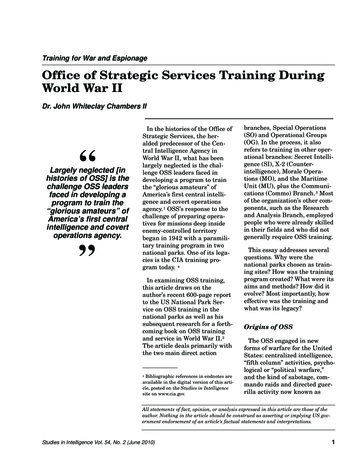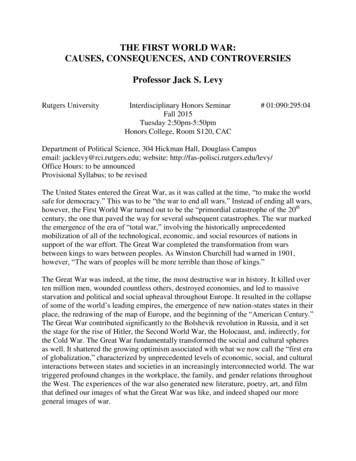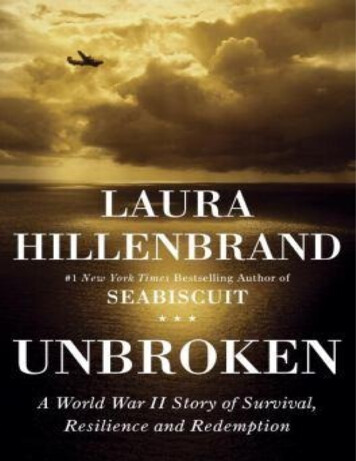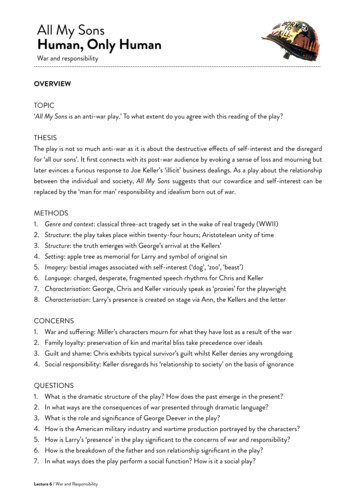
Transcription
Training for War and EspionageOffice of Strategic Services Training DuringWorld War IIDr. John Whiteclay Chambers II“Largely neglected [inhistories of OSS] is thechallenge OSS leadersfaced in developing aprogram to train the“glorious amateurs” ofAmerica’s first centralintelligence and covertoperations agency.”In the histories of the Office ofStrategic Services, the heralded predecessor of the Central Intelligence Agency inWorld War II, what has beenlargely neglected is the challenge OSS leaders faced indeveloping a program to trainthe “glorious amateurs” ofAmerica’s first central intelligence and covert operationsagency. 1 OSS’s response to thechallenge of preparing operatives for missions deep insideenemy-controlled territorybegan in 1942 with a paramilitary training program in twonational parks. One of its legacies is the CIA training program today. aIn examining OSS training,this article draws on theauthor’s recent 600-page reportto the US National Park Service on OSS training in thenational parks as well as hissubsequent research for a forthcoming book on OSS trainingand service in World War II. 2The article deals primarily withthe two main direct actionBibliographic references in endnotes areavailable in the digital version of this article, posted on the Studies in Intelligencesite on www.cia.gov.abranches, Special Operations(SO) and Operational Groups(OG). In the process, it alsorefers to training in other operational branches: Secret Intelligence (SI), X-2 (Counterintelligence), Morale Operations (MO), and the MaritimeUnit (MU), plus the Communications (Commo) Branch. 3 Mostof the organization’s other components, such as the Researchand Analysis Branch, employedpeople who were already skilledin their fields and who did notgenerally require OSS training.This essay addresses severalquestions. Why were thenational parks chosen as training sites? How was the trainingprogram created? What were itsaims and methods? How did itevolve? Most importantly, howeffective was the training andwhat was its legacy?Origins of OSSThe OSS engaged in newforms of warfare for the UnitedStates: centralized intelligence,“fifth column” activities, psychological or “political warfare,”and the kind of sabotage, commando raids and directed guerrilla activity now known asAll statements of fact, opinion, or analysis expressed in this article are those of theauthor. Nothing in the article should be construed as asserting or implying US government endorsement of an article’s factual statements and interpretations.Studies in Intelligence Vol. 54, No. 2 (June 2010)1
Getting Ready for ConflictIn early 1942, at least a dozen American instructors for SO,and a few for SI, attended all or part of a basic four-weekcourse the British had established at Camp-X east of Toronto,Canada.irregular warfare. The Britishhad begun such operations in1940 through the Special Operations Executive (SOE) and theSecret Intelligence Service(SIS), the former established asa result of Prime Minister Winston Churchill’s order to rouseresistance against the Germanarmy in occupied countries and“set Europe ablaze.” 4In the United States, WilliamJ. Donovan, a World War I heroand a Wall Street lawyer withextensive contacts on both sidesof the Atlantic and a keen interest in modern warfare, soughtto create a comparable organization. President Franklin D.Roosevelt named him directorof the new, civilian Office of theCoordinator of Information(COI) in July 1941. Existingagencies, especially the Military Intelligence Division, theOffice of Naval Intelligence,and the FBI, vigorouslyopposed the new and centralized intelligence agency, but theUS entry into World War II inDecember 1941 led to a dramatic expansion for Donovan’sorganization.In June 1942, Roosevelt reorganized COI as the OSS, inwhich military and civilian personnel had responsibilities inthe fields of intelligence andcounterintelligence, psychological warfare, and guerrilla operations, including sabotage and2the coordination of resistancemovements. Donovan nowreported to the newly formedJoint Chiefs of Staff, but he alsoretained direct access to thepresident. 5Among the units establishedin the new OSS were the Special Operations and the SecretIntelligence Branches. SO tookthe lead in obtaining instructors and recruits and setting upa substantial paramilitarytraining program. Its drivingforce was Lt. Col. Garland H.Williams, a no-nonsense character with a highly successfulcareer in federal law enforcement and the Army Reserves.The native Louisianan hadbeen head of the New Yorkoffice of the Federal Bureau ofNarcotics and a reserve majorwhen the army called him toactive duty in January 1941.That year, he created a training program for the army’s newCounter-Intelligence Corps andthen went on to assist at thearmy’s infantry and chemicalwarfare schools. Transferring toDonovan’s organization in earlyJanuary 1942, Williams beganrecruiting and training the firstSO force. 6First Thoughts on TrainingIn establishing the SO training program, Williams drew inpart on Britain’s experience inunconventional warfare since1940. Donovan had visited thetraining schools SOE and SIShad set up in secluded countryestates in Britain. Now he, Williams, and other senior officersinspected a new, secret SOEtraining camp in Canadalocated on 275 acres of rollingfarmland on the edge of LakeOntario, 25 miles east of Toronto. SOE’s Camp-X wasdesigned to provide secret agentand saboteur training for Canadians and for some Americans.In early 1942, at least a dozenAmerican instructors for SO,and a few for SI, attended all orpart of SOE’s basic four-weekcourse; beginning in April, theywere followed by the first ofseveral dozen Americanrecruits who trained there. 7A typical day for trainees atCamp-X began with a five-milerun and two hours of gymnastics followed by lectures on various topics, such as personaldisguise, observation, communications, and field craft. Theafternoon might include training with explosives in an openfield, practice with small armsat a basement firing range,parachute jumping from a 90foot jump tower, or crawlingunder barbed wire whilemachine guns fired live roundsoverhead. In the evening, students might study assignments, go out on nightmaneuvers, or undergo simulated interrogations by instructors or by one of the Germanofficers from an enemy officerinternment camp nearby. Thecourse ended with the field testing of students: finding theirStudies in Intelligence Vol. 54, No. 2 (June 2010)
Getting Ready for Conflictway back to the camp afterparachuting into a forest 30miles away or infiltrating alocal defense plant. 8Garland Williams also drewon his own experience with theFederal Bureau of Narcoticsand the US Army as well asDonovan’s vision for the organization. Williams rejected British-style country estates asinappropriate for training saboteurs and guerrilla leaders whowere known to operate from forest and mountain hideouts. Theideal special operations training camp, he wrote, would be“situated in the country andthoroughly isolated from thepossible attention of unauthorized persons” with plenty ofland, at least several hundredacres, located “well away fromany highway or through-roadsand preferably far distant fromother human habitations.” Butit should be within about 50miles from OSS headquartersin Washington. 9 Williams foundwhat he was looking for in twonearby national parks.The First SitesOperated by the NationalPark Service, the two woodlandproperties, then called Recreational Demonstration Areas,were located in the CatoctinMountains near Thurmont,Maryland (where the presidential retreat called Shangri-La,now Camp David, would laterbe built), and in rolling woodlands in the watershed of Chopawamsic and Quantico CreeksStudies in Intelligence Vol. 54, No. 2 (June 2010)near Quantico, Virginia. Eachpark comprised more than9,000 forested acres and contained several, recently builtcabin camps. The appeal ofCatoctin Mountain Park andwhat was later called PrinceWilliam Forest Park was theirsecluded yet convenient location; expansive wilderness terrain; existing, rusticaccommodations; and the factthat they were already ownedby the federal government. 10Neither the National ParkService nor the Department ofthe Interior wanted to turn theparks over to the OSS for paramilitary training camps. ThePark Service’s mandate was toconserve the nation’s parks forthe public, and its cabin campsthere were used for summerrecreation bycharitable organizations servingneedy, urbanyouths from Baltimore and Washington. But thedeclaration of warenabled the WarDepartment todeclare their use amilitary necessity, and a reluctant actingsecretary of theinterior signed anagreement, leasing the propertiesfor the duration,albeit with provisions that the military abide bycertain conservation restrictionsand restore theparks as much as3
Getting Ready for ConflictThroughout the war, park superintendents made regular visitsand informal inspections of the properties, and they did not always like what they saw.possible to their prewarcondition. 11Between 1942 and 1945, theOSS pretty much did what itwanted in the two nationalparks. The public was excluded,the park rangers gone, and thepark superintendents movedout to the nearest towns. OSSerected obstacle courses, firingranges, and demolition areas,winterized the facilities,expanded the dinning halls,constructed some classroomsand a few barracks and builtarmories and munitions magazines. Every SO training camphad a commanding officer and achief instructor, each with aseparate staff.Groups of trainees began toarrive in closed army trucks tothese undisclosed locations. Attheir peak, Catoctin’s two subcamps could accommodate up to400 men, including traineesand staff members, and PrinceWilliam’s six subcamps couldhold 900 men (there were nowomen at the training camps inthe parks). 12The Stomach-ChurningRough HouseThroughout the war, parksuperintendents made regularvisits and informal inspectionsof the properties, and they didnot always like what they saw.Some abandoned farm houseswere destroyed during mortar4practice and field exercises.Park rules against huntingwildlife and cutting down treeswere violated. The Catoctinsuperintendent complained tothe camp commander whentrainee/hunters killed a rabbit;he lodged a formal protest whena dozen large trees were cutdown; and he expressed dissatisfaction when trainees shotseveral wild turkeys. Midwaythrough the war, the PrinceWilliam superintendent wascommissioned an officer at theadjacent Marine Base in Quantico and assigned to supervisecontrol of brush fires there, ashe did in his park. Accompanied by his dog and in his parkranger hat and uniform, thesuperintendent continued toinspect the park property onweekends. Appalled at the ruthlessness involved in the training of the OSS saboteurs andguerrilla leaders, he later complained of what he called “thestomach-turning roughhouse ofthe OSS!” 13Although SOE had considerable influence in the beginning,not only through Camp-X, butby temporarily lending instructors and providing copies of itsmanuals, lectures, and trainingmaterials, as well as the latestexplosives and Allied and Axisweapons, OSS eventually wentits own way. It never adoptedthe British model of twoentirely separate governmentagencies for secret intelligenceand special operations (SIS andSOE). It rejected the class formality between officers andenlisted men and the rigid military discipline of SOE trainingcamps. By mid-1943 only oneBritish instructor remainedwith the Americans.The OSS was a most un-military military. With little attention paid to regular armyprotocol and procedure, OSStraining camps fostered ahighly informal atmosphere.There were few distinctionsbetween officers and enlistedmen and little or no saluting ordrill in the manual-of-arms ormarching in ranks. Emphasiswas on individual responsibility and initiative. “I’d ratherhave a young lieutenant withguts enough to disobey an orderthan a colonel too regimented tothink and act for himself,”Donovan declared. 14Special OperationsCurriculumThe training program thatGarland Williams envisioned inearly 1942 consisted of a general curriculum that providedpreliminary, basic, andadvanced training courses toSO and SI recruits before theyprepared for their differenttypes of missions. His trainingplans provided elasticity andallowed for varying the instruction according to a person’s previous experience, specialqualifications, or assignment.Williams believed that the preliminary two-week, “toughingStudies in Intelligence Vol. 54, No. 2 (June 2010)
Getting Ready for Conflictup” course of demanding physical exercise, obstacles, nightmarches, and tryouts in closecombat and weapons skillswould weed out the unqualifiedand help to classify acceptedindividuals for future instruction and assignment.Toughening up was to be followed by two weeks of basic SOtraining drawing on more intellectually demanding skillsderived from SOE’s curriculum: identification of targets ofopportunity, observation, intelligence gathering, sabotage,and so on. In addition to learning new skills, the students,Williams explained, “will alsobe physically and mentally conditioned during these twocourses for the aggressive andruthless action which they willbe called upon to perform atlater dates.” 15After completing the preliminary and basic courses, the student would go on, underWilliams’s plan, to either parachute or seaborne infiltrationtraining and then to one of theadvanced schools that would beset up for intelligence work,propaganda, sabotage, or guerrilla leadership. Throughout allof the training, the focus was tobe on imparting skills, buildingup the candidate’s physical condition and self-confidence, anddeveloping the student’s individual initiative, personal courage, and resourcefulness. Allinstruction, Williams emphasized, should be practical, nottheoretical. Instructors shouldkeep lectures short, rely more“The students will also be physically and mentally conditioned for the aggressive and ruthless action which they willbe called upon to perform at later dates.”on the “discussion or conference method of instruction” andmake good use of “interest-provoking equipment and materials.” Indeed, OSS producedhundreds of training films, several of them by Hollywooddirector John Ford. 16 Classroominstruction, Williams added,should alternate with outdoordemonstrations and practice.As he summarized his pedagogical philosophy: “Whenever possible, the system of instructionwill follow the principles ofexplanation, demonstration,application, and examination.” 17Later, the advanced courseswould include “schemes”—mockattacks on real targets. Students would be assigned, forexample, to place imitationexplosives under a nearby railroad bridge or radio tower, ordirected to infiltrate a defenseplant in Baltimore or Pittsburgh and obtain classifiedinformation or leave a dummyexplosive charge. Williams continued to stress that the focuswas on the individual:Constant thought will begiven to the building of ahigh state of morale and ahigh esprit de corps. However, the militaryindoctrination will be sohandled as to develop tothe maximum extent hisindividual initiative, personal courage andresourcefulness. Empha-Studies in Intelligence Vol. 54, No. 2 (June 2010)sis will be constantlyplaced on the development of this agent as anindividual and not as afighter who is only effective when under closeleadership. The guerrillaconcept of warfare will bethe guiding principle. 18The first classes in basic special operations training beganin early April 1942 at CatoctinNational Park, which was designated Training Area B forbasic OSS training. The firstadvanced course began a fewweeks later in Prince WilliamForest Park’s western sector,some 5,000 acres, designatedArea A for advanced training.At Area B, a dozen instructorstaught about two dozen students per course in those earlydays. The number of instructors and students would growinto the hundreds at the peakuse of the camps in the twoparks during 1943–44. Becauseof the drive to produce substantial numbers of SO agents, thisbasic course lasted two to threeweeks. 19During the war, the topictitles in the basic special operations curriculum remainedroughly the same, but the content would change as a result ofnew information from overseas.Basic SO training, although initially held at Area B, came to beknown as A-4 training because,for most of the war, it was cen-5
Getting Ready for ConflictOSS jettisoned standard marksmanship in favor of practicalcombat shooting. With their pistols, students learned “instinctivefire.”tered at Area A’s subcamp A-4in Prince William Forest Park.It included such topics as physical conditioning, close combat,weaponry, demolitions, mapreading, field craft, Morse code,first aid, as well as intelligencegathering and reporting, andenemy organization and identification. Field problemsincluded night map and compass exercises, reconnaissanceand patrol, and simulatedsabotage. 20Physical conditioning in Special Operations’ courses formembers of SO, or SI, MO, orwhoever took its paramilitarytraining, meant not just morning calisthenics but challenging exercises testing limits ofstamina and nerve. On a giant,timbered jungle-gym more than40 feet in the air, at Area B,Catoctin Mountain Park, forexample, trainees climbedpoles, walked narrow planksand swung from perilous platforms, testing themselves andsimulating clambering aroundbridge or tower beams or repelling down cliffs. They learnedhow to cross surging streamsand rivers on a single ropewhile gripping two overheadlines for balance. On obstaclecourses, they crawled under livemachine gun fire and dodgedalong booby-trapped trails studded with explosive trip wires.In 1942, William Casey, afuture director of central intelli-6gence, but then a young navalofficer and trainee in SecretIntelligence, did not crouchdown enough on the trail atsubcamp B-2. When he accidentally snagged a trip wire, it triggered a block of TNT attachedto a nearby tree. The blast senta chunk of branch hurtlingthrough the air, striking him onthe side of the face and breaking his jaw. 21Because of the OSS emphasison prowess, self-confidence, andself-reliance on hazardous missions, instruction in close-combat techniques, armed andunarmed, was a major component of the training. Its chiefinstructor was a William (“Dan-Instructors William Fairbairn (left)and Hans Tofte.gerous Dan”) Fairbairn, legendary former head of the BritishShanghai riot squad, who hadtaught for SOE in Britain andCanada and then for OSS from1942 to 1945. He had foughtChinese street gangs, masteredAsian forms of martial arts, andinvented a slim, razor-sharp stiletto for use on sentries. Fairbairn knew a hundred ways todisable or kill an enemy withhis hands, his feet, a knife, orany instrument at hand. “Forget about fighting fair,” wasFairbairn’s mantra. “In war, it’skill or be killed.” 22Under the direction of Fairbairn and Rex Applegate, areservist and military policeinstructor from Oregon, OSSjettisoned standard marksmanship in favor of practical combat shooting. With their pistols,students learned “instinctivefire.” Instead of carefully aiming at fixed “bull’s-eye” targets,OSS trainees jerked into acrouched position and quicklysqueezed off two rounds at atime. The idea was to kill orstartle an armed enemy beforehe killed you. 23For realistic training and testing, Fairbairn created special,dimly lit structures that hecalled “pistol houses” or “indoormystery ranges.” “Under varying degrees of light, darknessand shadows plus the introduction of sound effects, movingobjects and various alarmingsurprises,” he explained, “anopportunity is afforded to testthe moral fiber of the studentStudies in Intelligence Vol. 54, No. 2 (June 2010)
Getting Ready for Conflictand to develop his courage andcapacity for self control.” 24Students called it a “house ofhorrors,” and one rememberedit this way:Each of us over a period ofa couple of days would beawakened in the middle ofthe night and hauled off tocarry out a special mission. When it came mytime, I was told that therewas a Nazi soldier holedup in a building and thatit was my job to go in andkill him. I was given a .45and two clips. The house Iwas sent into was a loghouse with long corridorsand stairways. I wasn’tsure whether there reallywas a Nazi soldier there ornot. I kicked a door openwith my gun at the ready.Paper targets with photographs of uniformedGerman soldiers jumpedout at me from every corner and every window anddoorway. We had beentaught to always fire twoshots at the target. Theremust have been six targetsbecause I got two bullets ineach one. The last one wasa dummy sitting in a chairwith a lighted cigarette inhis hand. If you didn’tshoot him you failed thetest. 25For sabotage training, OSSinstructors taught studentsabout various forms of explosives, including the new moldable, gelatin-like “plastic”compounds, which were morestable and contained moreexplosive power than TNT.Trainees learned how to usevarious kinds of explosives,fuses, and timing devices todestroy railroad tracks, trains,bridges, tunnels, dams, radioTraining in the “House of Horrors,” with Fairbairn (right) observing the student’sreactions.Studies in Intelligence Vol. 54, No. 2 (June 2010)towers, supply depots, andindustrial facilities to impedeenemy operations.In practical field exercises,students practiced escape, evasion and survival techniques, aswell as tactical operations. Astraining progressed, the intensity increased. Lt. John K. Singlaub, SO, then a young UCLAgraduate fresh from paratroopschool who would soon serve inFrance, later wrote:By the end of November[1943], our training atArea B had become agrueling marathon. Wefired American, British,and German weaponsalmost every day. Wecrawled through rainsoaked oak forests atnight to plant live demolition charges on floodlitsheds. We were introduced to clandestine radioprocedure and practicedtyping out code andencrypting messages inour few spare moments.Many mornings beganwith a run, followed by apassage on an increasingly sophisticated anddangerous obstacle course.The explosive chargesunder the rope bridgesand wire catwalks nolonger exploded to oneside as exciting stageeffects. Now they blasteddirectly below, a momentbefore or after we hadpassed. 26OSS field training exercisesoften culminated in mock espionage and sabotage missions.7
Getting Ready for ConflictLocal bridges and dams werehandy simulated targets fornighttime raiding parties, andnearby industrial facilitiesoffered similar opportunities forpracticing reconnaissance andsabotage. Most students succeeded in penetrating theplants, using cover stories andforged documents, but somewere nabbed by the police orthe FBI. A most embarrassingincident was the capture, “redhanded,” of the professionalbaseball catcher and spy MoeBerg trying to infiltrate adefense plant in Baltimore. 27Other Branches/OtherSchoolsThe other operational arms ofOSS established their trainingprograms more slowly and withfewer students than SpecialOperations did with its vision ofthe mass production of commando-like saboteurs, bold,brash gung-ho men with submachine guns and plastic explosives, whom other branchessometimes belittled as the“bang-bang boys.” 28 SecretIntelligence, which had taughta handful of agents in a room atOSS headquarters in the firstfour months of 1942, opened itsschool in May 1942 on a 100acre country estate 20 milessouth of Washington. Designated RTU-11, but known informally as “the Farm,” it beganwith a class of eight. It had acapacity of nine staffers and 15SI students for its four-weekcourse in espionage, ciphers,communications, concealment,and handling agents, as well asweapons and martial arts.8In the fall of 1942, the Communications Branch established its school in the NPScabin camps in the eastern sector of Prince William ForestPark. Labeled Area C, it trainedthe radiomen who would operate the regional base stationsand many of the portable fieldradios in Commo’s global clandestine shortwave radio network. Communications trainingat Area C took three months.OSS established Area D inwhat may have been an oldCivilian Conservation Corpscamp in 1,400 isolated woodedacres on the rural eastern shoreof the Potomac River some 40miles south of Washington. Itsmission was instruction andpractice in waterborne raidsand infiltration. After the Maritime Unit was formed in 1943,it moved its training sites forunderwater demolition teamsand others first to Florida, thenthe Bahamas, and finally toCalifornia. 29Area E, two country estatesand a former private schoolabout 30 miles north of Baltimore, was created in November1942 to provide basic SecretIntelligence and later X-2 training—as a result, RTU-11became the advanced SI school.Area E could handle about 150trainees. When the MoraleOperations Branch was established to deal in disinformationor psychological warfare,“black” propaganda, men andwomen of the MO Branch alsotrained at Area E, althoughmen from MO, SI, and X-2 oftenreceived their paramilitarytraining in the national parks. 30Communications school class in coded telegraphy at Training Area C.Studies in Intelligence Vol. 54, No. 2 (June 2010)
Getting Ready for ConflictThe Congressional CountryClub and OG TrainingIn stark contrast to the rusticcabins of the national parks,OSS’s grandest training facilitywas the magnificent Congressional Country Club, with itspalatial clubhouse, its fancytennis courts and Olympicswimming pool, its 400 acres ofmanicured lawns, well-maintained fairways and greens ofits acclaimed golf course, andthe surrounding woods. Established in the 1920s, with Herbert Hoover as foundingpresident, the club had beenhard hit by the Great Depression and in 1943 was bankruptand in foreclosure proceedings.Consequently, the board ofdirectors was delighted whenDonovan offered to lease thefacility for the duration at amonthly rent that would morethan meet the mortgage payments. In addition, the WarDepartment agreed to restorethe property to its prior condition at the end of the war. 31Designated Area F, its location in Bethesda, Maryland,made it easily accessible fordignitaries from the capital lessthan 20 miles away, and it provided a dramatic locale forDonovan to showcase one of hismost original concepts, ethnic,commando-like OperationalGroups (OGs). For their training the club was transformed—its entrance waylined with tents, fairways tornup into obstacle courses andfiring ranges, and the elegantclubhouse converted intoclassrooms and a mess hall.The Congressional Country Club, Training Area F, as shown in an OSS briefingboard.It was one of Donovan’s greatinsights that he could obtainfrom America’s multiethnicpopulation combat guerrillateams that could successfullyinfiltrate enemy-occupied countries because its membersspoke the language, knew theculture, and, in fact, were oftenthe descendants of immigrantsfrom that country. By 1943, theJoint Chiefs of Staff acceptednot only increased numbers ofSpecial Operations teams butalso Donovan’s proposal forthese larger ethnic, or at leastforeign-speaking, OGs. 32Special Operations teams andOperational Group units hadmany similarities. Recruits forboth had to meet the high physical standards required forparachute infiltration and wilderness survival as well assuperior mental and psychological standards of uncommon stability, judgment, andStudies in Intelligence Vol. 54, No. 2 (June 2010)independent thinking. BothSOs and OGs were supposed tobe fluent in a foreign languageand both would be engaged insabotage and irregular warfare, but SO generally workedin teams of two or three andoften focused on particular actsof sabotage or subversion. Themost famous SOs were the“Jedburghs”—nearly 100 multinational, three-man teams, twoofficers and a radio operator—most of which were composed ofa Frenchman and either aBriton or an American, whoreceived substantial extratraining at SOE schools in Britain and were parachutedbehind German lines in conjunction with the invasion ofFrance. 33In contrast, OGs were organized into sections of 34 men aswell as half sections of two officers and 13 NCOs, includingweapons and demolitions spe-9
Getting Ready for ConflictTraining emphasized that unconventional warfare behindenemy lines was a hazardous undertaking and required notonly skill but a certain degree of ruthlessness.cialists, a shortwave radio operator, and a medic. Theseuniformed units were seen asmilitary forces capable of longerand more sustained independent action. In practice however, SOs and OGs often spentsimilar periods and engaged inthe same kinds of missions withresistance groups. 34 For Europe,Donovan created OSS Operational Groups for France, Italy,Greece, Yugoslavia, and Norway. The OGs (and some otherbranches) received their basicOSS training at Area F. 35OGs trained as units undertheir own officers togetherwith OSS instructors. To create the OG training program,a team of bright and boldyoung officers from the army’snew airborne units wasassembled under the leadership of Lt. Col. Serge Obolensky, a former Russian princeand New York socialite whohad fought the Germans inWorld War I, the Bolsheviks inthe Russian civil war, and whohad gone through SO trainingand studied guerrilla fightingafter joining the OSS at age51.The training curriculum forthe new Operational Groupsincluded a six-week basic training course. 36 It emphasized theneed for trainees to achieve proficiency, self-confidence, anddetermination and to recognizethat unconventional warfare10behind enemy lines was a hazardous undertaking andrequired not only skill but acertain degree of ruthlessness. 37In the OG curriculum, thePreliminary Course taught atArea F began with an hourintroducing and going throughthe training’s objectives. Overthe next few weeks, it wouldinclude 22 hours of map reading, sketching, and compasswork, both theoretical and fieldproblems; 20 hours of scoutingand pat
inspected a new, secret SOE training camp in Canada located on 275 acres of rolling farmland on the edge of Lake Ontario, 25 miles east of Tor-onto. SOE’s Camp-X was designed to provide secret agent and saboteur training for Cana-dians and for some Americans. In










